Yoga for Insomnia
I want to begin this post with a few facts.
In a 2019 annual stress survey conducted by American Psychological Association:
- A whopping 94% adults reported having workplace stress
- 66% went on further to state that it led to sleep deprivation or insomnia
- 42% of adults reported not doing enough to manage stress
- 20% reported doing nothing for their stress
I know what you’re thinking, we can likely assume that the first number is 100% for 2020.
Before COVID-19, the World Health Organization (WHO) had announced that noncommunicable diseases (NCDs) in which lifestyle is the major causative factor, have reached epidemic proportions. NCDs, also known as chronic diseases, include cardiovascular diseases (like heart attacks and stroke), cancers, chronic respiratory diseases (such as chronic obstructive pulmonary disease and asthma), diabetes, and more.
The good news is that NCDs are preventable by the implementation of ‘lifestyle medicine’ which is lifestyle as treatment as well as prevention. An important thing to note, however, is that chronic psychological stress can have direct and indirect effects on NCDs by changing biology and influencing behavior.
Probably not a big surprise.
The western world has often reduced the perception of yoga to a series of movements. Traditionally however, yoga is:
- A series of lifestyle changes
- Adoption of regular exercise
- A healthy diet
- Incorporation of mindfulness into all behaviors and interactions
In addition, the yogic school of thought manages psychological stresses through breathing exercises, deep relaxation and meditation.
Sounds like too much of an ask? Stay with me.
Insomnia can have many causes, but chronic stress and the tendency to minimize or dismiss personal needs, usually in order to meet work or family demands are common threads.
I know I caught you now.
Insomnia can create an imbalance between our sympathetic (fight or flight) and parasympathetic (rest and digest) nervous systems. It can lead to feelings of frustration, fatigue, depression, and anxiety. Chronic hyperarousal and feelings of defeat and hopelessness are also common.
Some of us suffer from insomnia while others have occasional experiences with insomnia.
As for any other medical diagnosis, recognizing the root cause of insomnia is the first step in being able to treat it effectively. For example, attempting to calm a restless mind through vigorous yogic practices is counterintuitive and can amplify feelings of discouragement and fretfulness due to a failed attempt. Similarly, just asking you to relax when you’re unable to actively relax can decrease trust and compliance.
Sleeplessness is a symptom of something else in our lives that is out of balance. Tada!
Most insomniacs endure the effects of inadequate sleep silently until it gets exponentially disruptive.
PSA: one in every five people you meet experiences insomnia. You’re certainly not alone.
Let’s finally get to the point, shall we?
Yoga has a three-part approach for treating insomnia:
- Restorative or pre-sleep practices
- Normalizing breathing patterns
- Calming the mind
Pick the top 3 causes of your insomnia from the following list and then follow the techniques and restorative poses that can assist in combating your insomnia.
- Stress?
- Stimulants?
- Anxiety?
- Fatigue?
- Depression?
- Restlessness?
- Distractibility?
- Hyperarousal?
For stress, restlessness, distractibility or hyperarousal
- Invest in bringing some regularity to your schedule. Eat and sleep at the same time everyday including weekends. Eat mindfully and deliberately with no distractions, trying to focus only on one thing – eating. To achieve this, set aside 10-20 minutes of your time strictly for meals on your calendar.
- Invest in a restorative or pre-sleep practice that will help your body exit the fight or flight state and enter a parasympathetic state where it uses less oxygen and glucose. Herbert Benson, a Harvard based cardiologist, termed this state as the ‘relaxation response’ and reports it is essential to learn how to enter this state to allow your body to recalibrate and rebuild resources that are depleted when sleep is poor or lacking. These restorative poses can be done even in the middle of a particularly stressful workday.
- If you have a hard time settling your busy mind, blow off some steam first. Try brisk walking, spirited dancing, small bursts of high intensity exercises. These can be done just long enough to release pent up energy before attempting to calm the nervous system.
- Breathing in these restorative poses should focus on sama-vritti (same wave breath) where the length of your inhalation and exhalation should be the same. For example: Inhale-1-2, Exhale 1-2; Inhale 1-2-3, Exhale 1-2-3; Inhale 1-2-3-4, Exhale 1-2-3-4.
- According to Benson, it takes at least 3 minutes to reach the state of relaxation, sometimes longer; so, aim to spend 3-10 minutes in one of the following poses of your choice.
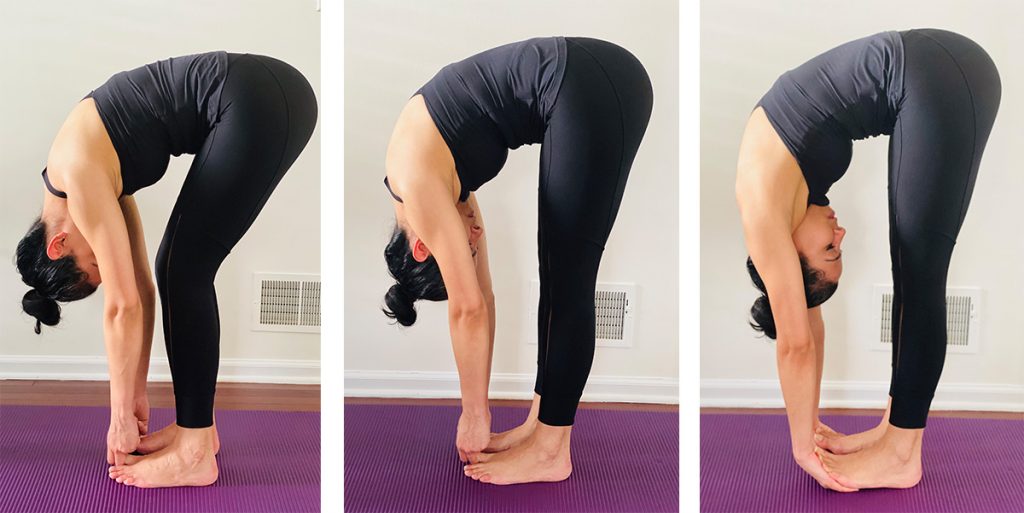
Big Toe Pose: Padangusthasana 3 versions side by side
(knees bent, toe grasp, palms under feet)
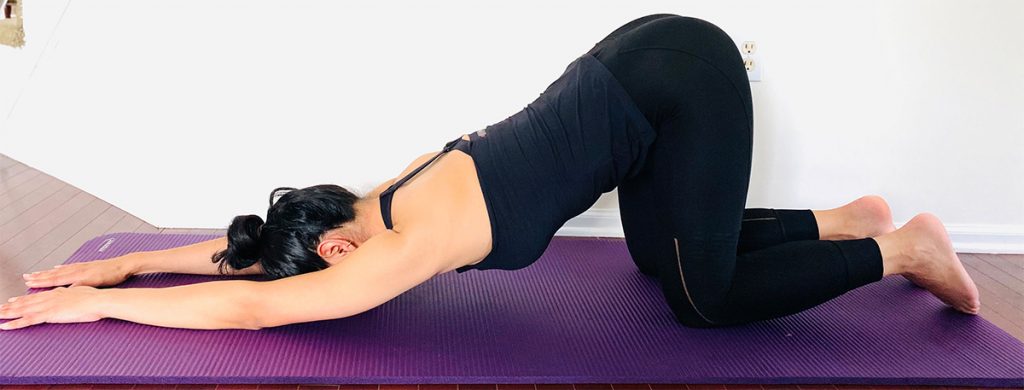
Extended Puppy Pose: Uttana Shishosana
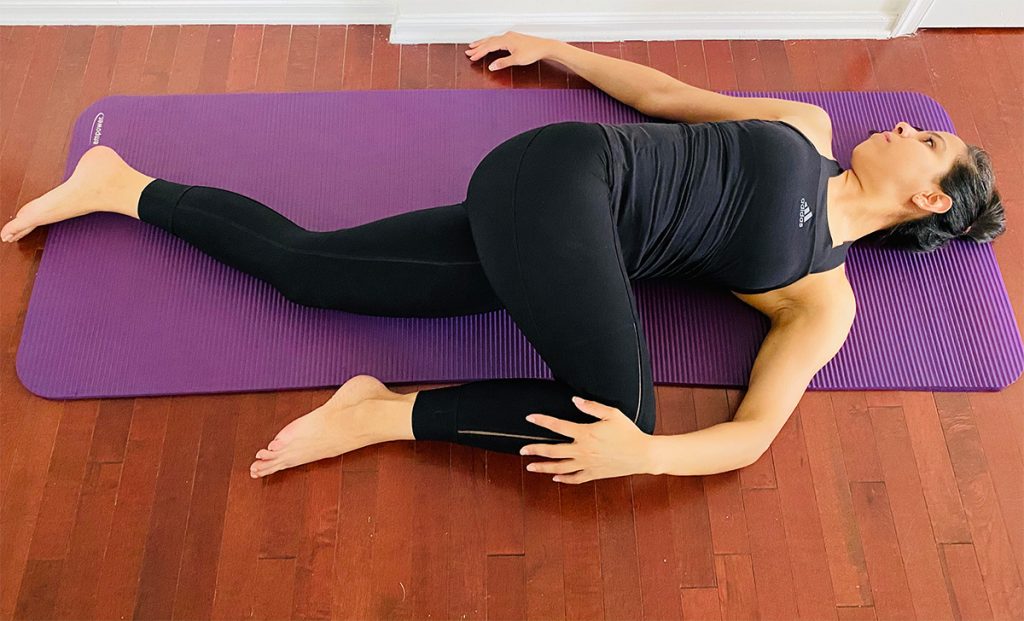
Fish pose: Supta matsyendrasana
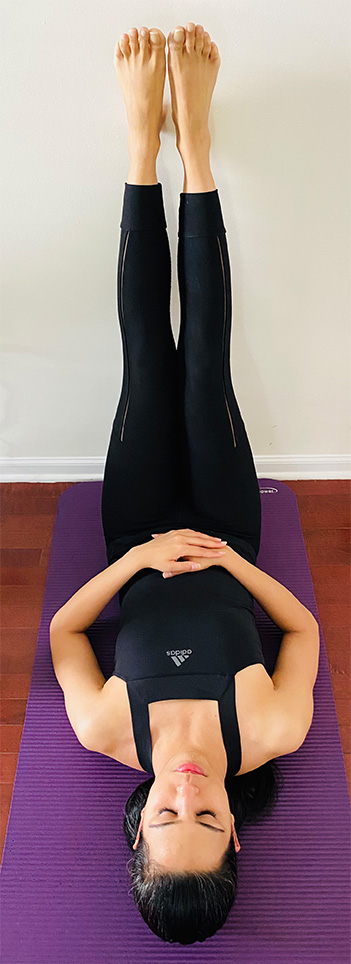
Feet on wall: Vipariti Karina
For anxiety- and depression-related insomnia
- Invest in a vigorous activity of your choice that creates exhaustion. Exercising to exhaustion may help you fall asleep faster.
- Follow it up with a restorative pose for 3-5 minutes.
- Breathing in this restorative pose should focus on the rise and fall of your abdomen and lengthening your exhalation. Inhale 1-2, Exhale 1-2; Inhale 1-2, Exhale 1-2-3; Inhale 1-2, Exhale 1-2-3-4;
- If concentrating on this breathing produces more anxiety, reset to same wave breathing and stay there.
- When going to sleep, first lie on your back and extend exhalation for 20 breaths. Repeat this on your right and left sides or your most comfortable sleeping posture and continue rotating slowly all the while inviting restful sleep.
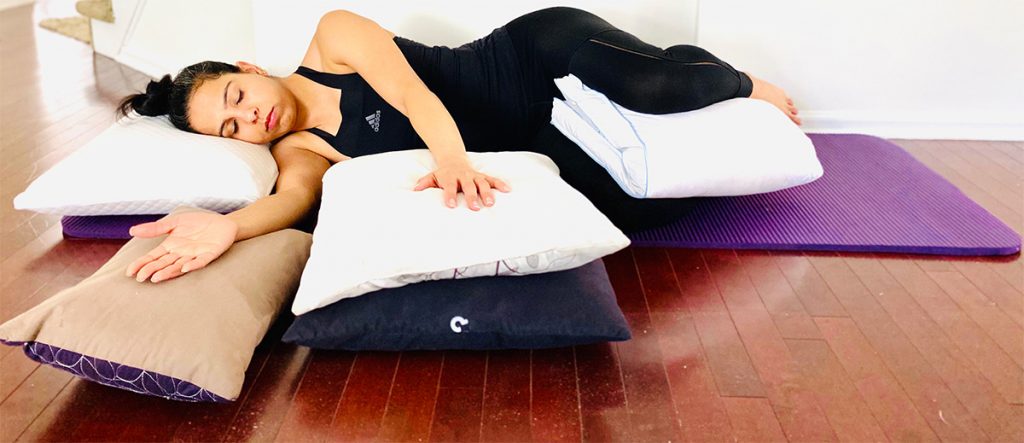
Side lying Savasana
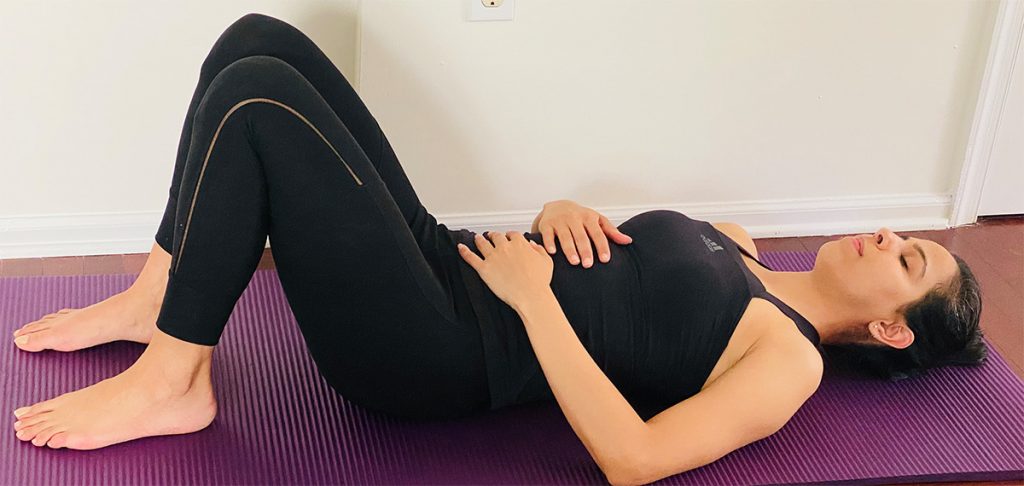
Still Lake pose: shant sarovarasana
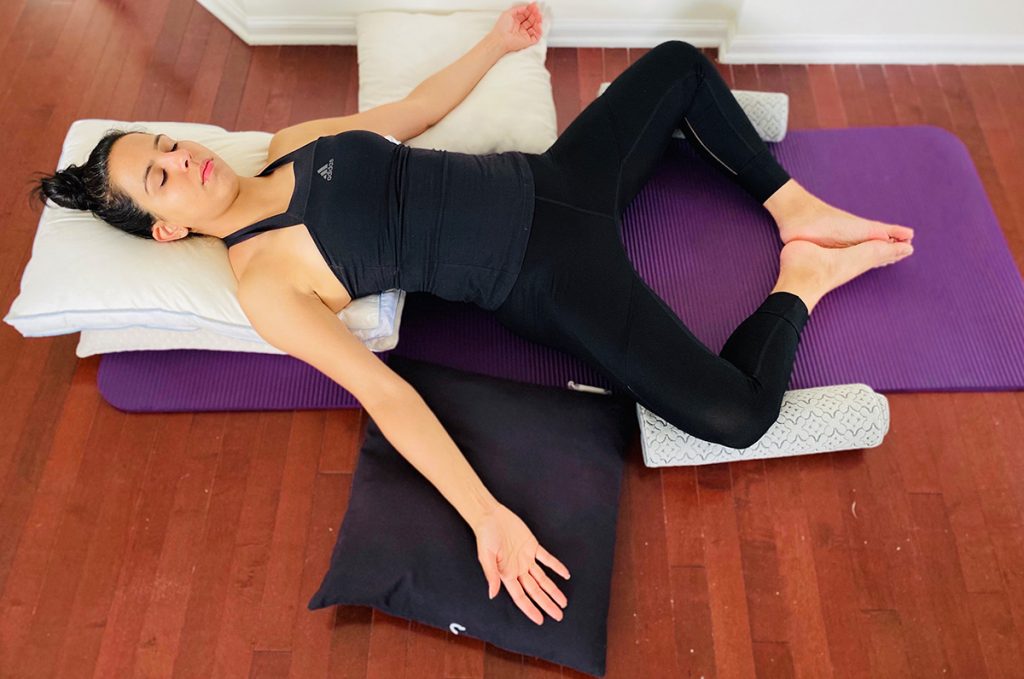
Reclining cobbler: Supta bhada konasana
Use pillows and towel rolls to mirror the picture

Crocodile pose: Makrasana
For general insomnia and fatigue
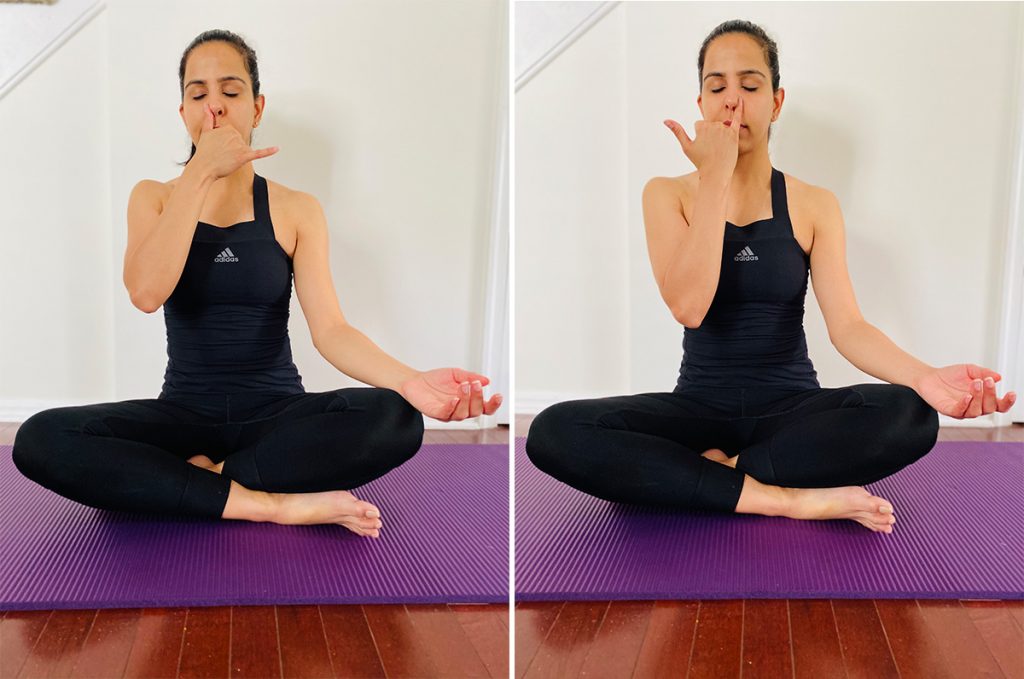
Moon breath – Chandra bhedana
(left) Inhale through the left nostril
(right) Exhale through the right nostril
To repeat. Inhale through the left nostril and exhale through the right
- Chandra bhedana or Moon breath: According to yoga, the left nostril activates the parasympathetic nervous system. Find a comfortable position, with your right nostril blocked, inhale through your left and exhale through your right. Repeat this for 1-3 minutes.
- Body sensing: Previously addressed by our psychologist, Molly Sherb, PhD in her article as one of the coping skills for stressful situations. Systematic body sensing can induce relaxation and reduce fatigue. Start body sensing in the feet and work up slowly, sensation by sensation through the legs and the hands to the face and jaw. Make sure all the senses are softening. Keep the various grasping mechanisms soft – jaw, eyes, ears, shoulders, palms, toes. Spend 10-15 minutes on cyclical body sensing all the while lengthening your exhalation.
- If you are someone who wakes up in the middle of the night and struggles to fall back asleep, try the moon-breath or body sensing until you fall back asleep.

Deadman’s pose: savasana
Remember, lifestyle medicine has no better cure in science than the involvement of one person.
You.
Resources:
The Principles & Practice of Yoga in Health Care
Sleep Recovery
Get up-to-date information and health tips in your social feeds